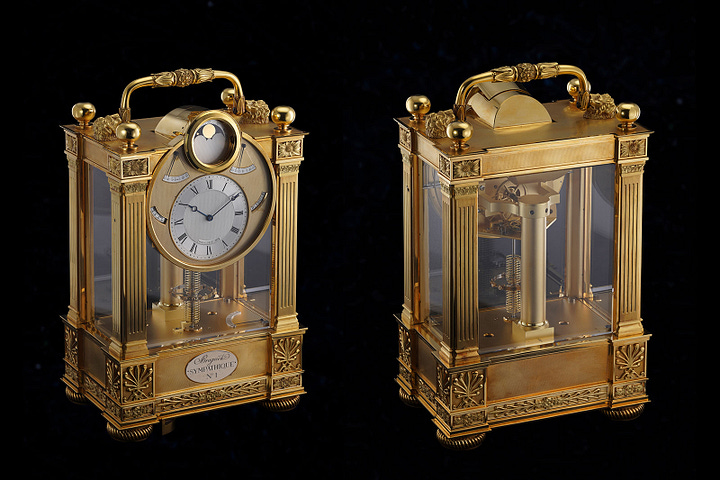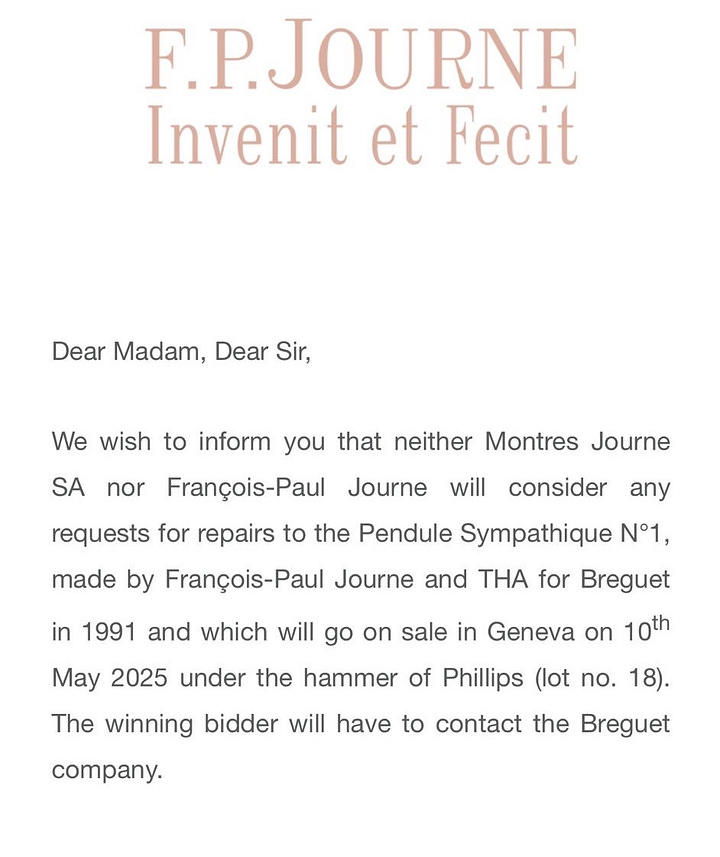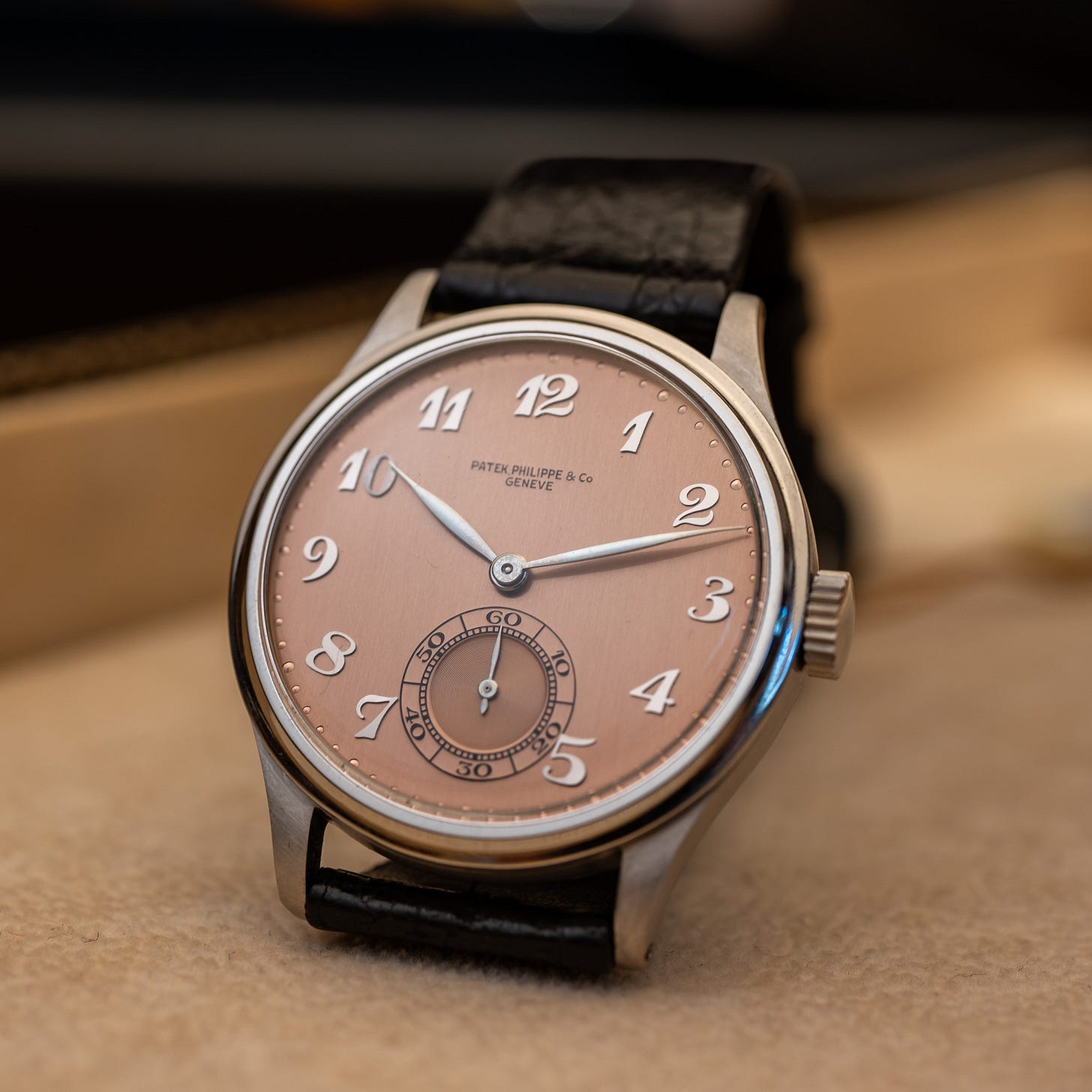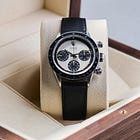Beyond Unpolished: Let's Talk About Restoration
Eric Ku on why he 'f*cking hates' that word—and what collectors get wrong.
Today, two quick hits from the Geneva auctions—more later this week. Then, a deep dive into case restoration with Eric Ku and Beau Goorey of LA Watch Works: Case polishing, laser welding, and why they both “f*cking hate the word unpolished.”


F.P. Journe sent an email and then bought his own clock
SJX reported that F.P. Journe bought Breguet Sympathique Clock No. 1 for $6.6 million at Phillips this weekend. It’s an unfathomable amount of money for a clock, but a very important one, it must be said—a tribute to the originals that Breguet made in the 1700s, with an accompanying wristwatch/pocket watch that the master clock winds and sets overnight.
Journe was the primary creator of the clock in 1991 for the Art of Breguet thematic auction. Now, it’ll become one of the main exhibits in the F.P. Journe Museum near its Geneva manufacture.
The news came a day after F.P. Journe sent an email to its clients before the sale, saying:
“Neither Montres Journe SA nor Francois-Paul Journe will consider any requests for repairs to the Sympathique No. 1. The winning bidder will have to contact the Breguet company.”
Brands buying their own pieces at auction is a well-established practice, but this does seem like one of the more deliberate interventions before a sale. Perhaps they were trying to give other bidders pause to keep the price down? On the other hand, we’ve often accused brands of bidding up their own pieces at auction to support their own markets.
Or, maybe they just wanted to take a passive-aggressive jab at Breguet?
BOTTOM LINE: No one will remember that email in five years, and I’m glad we’ll be able to see an important clock on public display for years to come. After all, Journe became inspired by the phenomenon of resonance when he had the opportunity to restore Breguet No. 3177, housed in Paris’ Arts et Métiers Museum. Perhaps Sympathique No. 1 will serve as the same inspiration for a future watchmaker.
Patek Philippe Ref. 530 Follow-Up
After the short auction preview last week, I was given more info about the steel Patek Philippe 530. Apparently, the Italian owner first posted it on Facebook after inheriting it from his father about two years ago. Initially, he didn’t want to sell—he had no idea about the importance or value of the watch. Eventually, dealers/sharks started circling, some making lowball offers in the range of €20,000 or below.
Other knowledgeable folks got in contact with the owner and connected him to auction houses. After learning the potential value of the watch, he started getting more pressure from family members to sell.
It ended up at Antiquorum, which placed a €200-400k estimate on the ref. 530.
The 530 sold for CHF 237,500 this weekend.
TAKE AWAY: There are dozens of stories like this across every auction weekend. While collectors get caught up on crooked numerals and cleaned dials—*raises hand*—it’s also a reminder that when these watches are family heirlooms, they can represent life-changing sums of money.
Let’s Talk About Case Restoration
Some previous Q&As from subscribers (here/here):
When are we going to get over the fact that some old watches have been restored? Seems people have accepted that with Patek dials. Are cases to follow? —@JUDAHROSENTHAL
While originality and condition are always sought after, there seems to be more acceptance for modification and heavy patina in the guitar and car circles….It seems like in watches most want as close to “mint” as possible, and originality/condition is king. Any thoughts on this? —@SAMHEPBURN
RESTORATION! Taboo, but perhaps no longer? You’ve got questions.
So I called up two guys who know: Eric Ku and Beau Goorey, co-founders of LA Watch Works, which provides collector-grade services for vintage watches.
When I call Beau Goorey, he’s fabricating brass screws for a vintage Tudor "Homeplate" chronograph—a process requiring precision to hundredths of a millimeter. "If you over-file by even a fraction, it's dead," he says.
So he does it by hand.
‘The Annoying Needs of Collectors’
Beau and Eric founded LA Watch Works in 2016 to cater to “the annoying needs of collectors,” according to Ku. An average watchmaker might get annoyed with specific requests or simply not listen.
LAWW specializes in case restoration—recutting chamfers, laser welding dings, and redefining case geometry.
“We’re keeping a watch alive,” Beau said. We’ve all heard stories of collectors sending special vintage watches to Rolex for service, only to have them come back with a polished case, relumed dial, or other service parts.
“Rolex cares about two things: timekeeping and water resistance,” Beau said. The case’s geometry is secondary.
Vintage Rolex service also isn’t cheap—think $15k+ for a Daytona—and manufacturer priorities often differ from collector values, something I’ve covered:
Restoration: Taboo to Trend?
“Nowadays, fewer people are asking me if a watch is unpolished,” Eric said. He mentioned the common analogy to cars, where restoration is widely accepted:
“People like to say: When is the watch world going to be like the car world? [Where restoration is more openly acknowledged.] I think it kind of is. When you have something original and truly fresh, it’s going for a lot more money.”
There’s a price for everything, and original condition can command a 1.5x premium over just pretty good.
One vintage expert’s 2024 auction report, sent to many auctioneers and dealers, even declared: “Restoration is not taboo any longer.” It reflects Beau’s observation that collectors increasingly appreciate properly finished cases, a dramatic shift from a decade ago when everyone was asking for unpolished.
“Restoration is still a dirty word,” Ku said, likening it to Hollywood, “where everyone’s got botox, lip filler, Ozempic, but no one wants to talk about it.”
“I f*cking hate that word.”
That’s what Ku said when I asked him about the word Unpolished. “Polishing is a standard practice in watchmaking and jewelry, so I don’t think saying ‘unpolished’ is useful or descriptive.” There’s no way to make such concrete statements if you don’t know a watch’s history.
“I agree 100%,” Beau said, “all these cases were hand-finished.” He says he’s even seen differently sized factory chamfers on the same watch.
🔒 Keep reading to see how LAWW approaches sympathetic restoration— including polishing, laser welding, and how they spot recut cases.
Keep reading with a 7-day free trial
Subscribe to Unpolished Watches to keep reading this post and get 7 days of free access to the full post archives.






